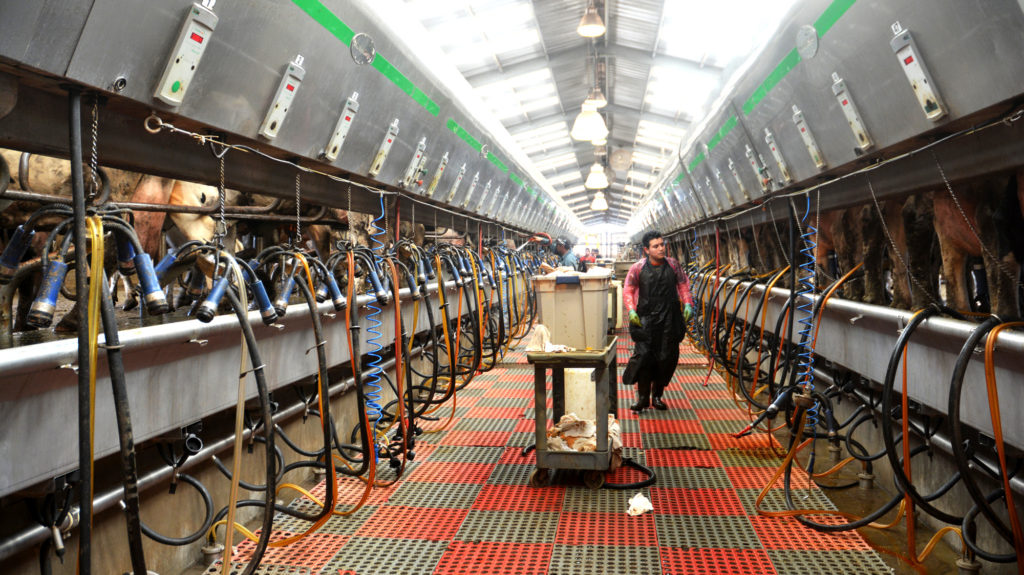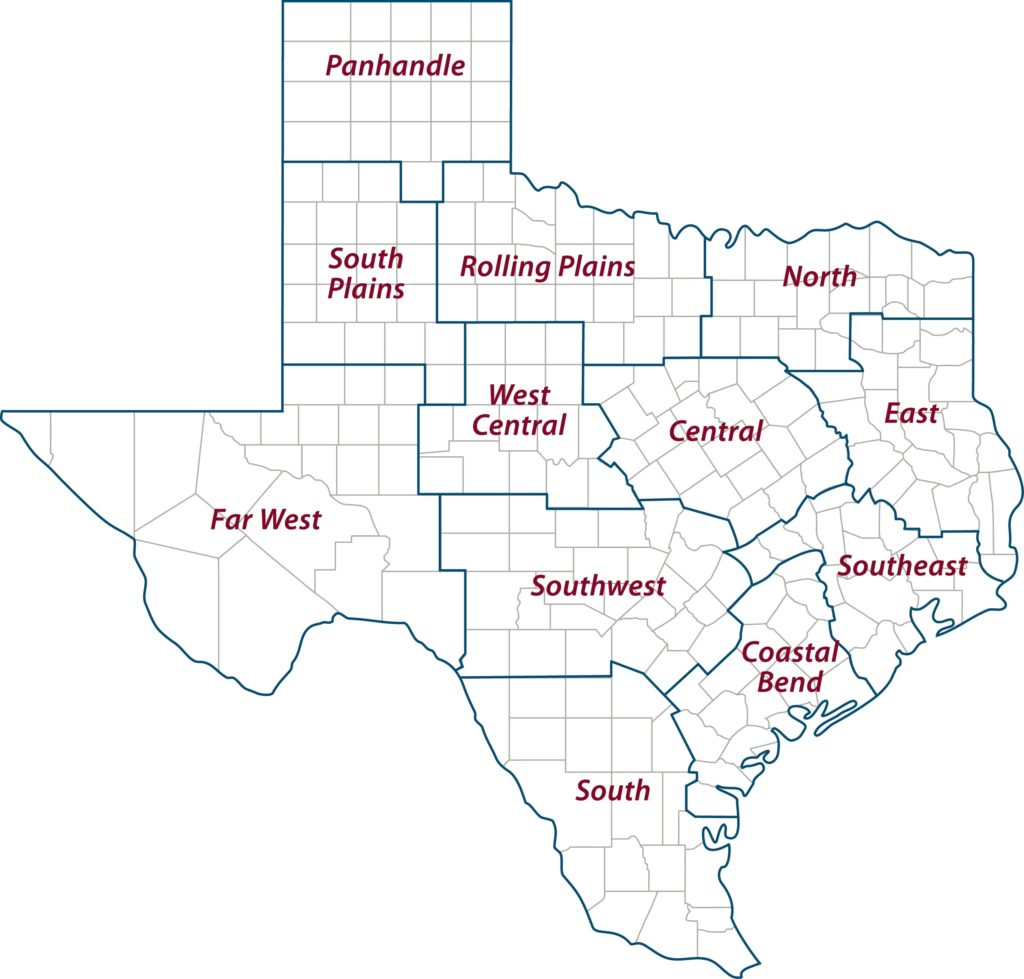Texas dairy production faring well despite setbacks, processing limits
Texas Crop and Weather Report – June 15, 2021
Texas dairy producers are experiencing better prices and improving market conditions as the economy continues to emerge from the pandemic, but processing limitations are holding them back, according to a Texas A&M AgriLife Extension Service expert.

Prices have rebounded compared to a year ago, said Jennifer Spencer, Ph.D., AgriLife Extension dairy specialist, Stephenville, and demand continues to be high for milk and milk products from cheese to ice cream.
Spencer said Texas has surpassed New York to become the nation’s fourth-leading milk producer with 1.32 billion pounds. But a lack of processing plant capacity has limited dairy expansion.
“It’s good and bad news,” she said. “Prices are good, but processors are overloaded with milk and a tiered program has been implemented giving producers an allotment of milk production before receiving a discount, so they’ve in turn had to pull back on production for now.”
Spencer said producers would like to be maximizing on the excellent crop production fueled by rains this spring but will have to wait.
Ongoing expansion of the state’s processing capacity with a new cheese processing facility in Amarillo will help to reduce the duration of the allotment program, she said. Spencer suspects the state will quickly move into third place ahead of Idaho for U.S. dairy production once processing volume allows Texas dairy producers to operate at maximum capacity and/or expand.
Texas dairy outlook good after ugly year
The good news is the Texas dairy industry overall emerged from more than a year of adversity, Spencer said. Unfortunately, some dairy operations didn’t. She said there were approximately 400 registered dairies in the state in 2019. There are now 351.
Texas dairy producers faced challenging times as COVID-19 disrupted the market destinations for milk, cheese and butter due to school and restaurant closures. Uniform milk prices fell after March and April and dropped from $19 per hundredweight to around $14 per hundredweight. For the year 2020, the average price was $15 per hundredweight.
Dairies also dumped around 14 million gallons and incurred losses of around $8 million in February as Winter Storm Uri brought the logistical chain from raw milk pick up to processing and product delivery to a virtual standstill.
Prices slowly recovered as the pandemic wore on but have yet to reach pre-pandemic levels – around $19 per hundredweight, Spencer said. Milk prices were around $17 per hundredweight and could be poised to climb during the summer.
“There are a lot of creative milk products, which helps demand, but there is also that summer demand for ice cream,” she said. “That and the drop in milk production by cows during the summer, and we could see prices climb a bit more.”
Increased export demand adds another element to price forecasts being good for producers, Spencer said, adding the future for Texas dairy production appears much brighter than in 2020.
“There have been positive developments lately,” she said. “Once the additional processing is available, it’s possible that Texas could move into third place, but the two top producers – California and Wisconsin – are way ahead. But, over the next decade with all the growth in the Panhandle, who knows?”
AgriLife Extension district reporters compiled the following summaries:

CENTRAL
Conditions were sunny, hot and humid, which should hasten crop maturity. Fields were starting to dry enough to allow winter wheat and oat harvests. Conditions of both crops were remarkably good considering the record amount of rainfall received over the past three weeks. Both sorghum and corn crops were lush and excellent. Some growers were locked out of spraying for weeds, and some fields were full of fall panicum. Most corn was in the milk stage and entering early dough. Corn producers were expecting hotter, drier conditions may advance mite populations. Cotton stands that survived excess rainfall and soil saturation were squaring, but some fields exhibited thinning stands and stunted growth. Cotton root rot was reported, and producers were spraying for thrips and weeds, but there was light insect pressure overall. Second forage cuttings began with drier days in the forecast. A heavy, high-quality second cutting was expected.
ROLLING PLAINS
Rains ranging from 2-6 inches fell in Cottle County, while Palo Pinto County reported up to 2.5 inches and Wilbarger County reported 1-2 inches. Many counties reported drier conditions. Producers were still waiting to get into fields. Pastures greened up significantly. Conditions were hot and humid as temperatures reached 100-plus degrees. Cotton, sorghum, hay grazer and Sudan grass were planted. Corn and sorghum looked good. Wheat harvest was ramping up in areas dry enough to access fields. Producers in Wilbarger County reported 30-90 bushel-per-acre yields of wheat. Grasshoppers were starting to show up. Some producers were cutting hay, and bales were mostly a mix of cool-season and warm-season grasses. Coastal Bermuda grass should take off soon. Cattle looked good, and calves were making good gains. Stocker calves looked good as well with plenty of grazing.
COASTAL BEND
No measurable rainfall was received with hot, dry and summer-like weather conditions. Soils were still very wet but starting to drain off and dry up. Corn and sorghum were doing well. Cotton that got a late start was not looking as healthy as earlier-planted cotton that had grown some prior to the continuous rains. Rice was doing well. Hay was maturing in the fields, and some areas were still too wet to access, but in other areas, hay that needed harvesting weeks ago was being cut and baled. Rangeland and pasture herbicide applications continued with favorable weather. Mosquito numbers declined. Livestock auctions were limited due to wet conditions.
EAST
Rainfall mostly subsided for now. Producers were trying to cut and bale hay while the weather was clear and warm, but many areas were still far too wet to get equipment in without being stuck. Pasture and rangeland conditions were good to excellent. Subsoil and topsoil conditions were surplus. Livestock were in good condition. Horn fly, mosquito, horse fly and house fly populations skyrocketed. There were reports of Bermuda grass stem maggots and armyworms in hay fields. Feral hogs were also very active.
SOUTH PLAINS
Fields were still drying out after more rainfall. Several producers reported hail damage to emerging cotton. As the fields dried out many were able to finally make a first cutting of hay. Producers were able to finish baling triticale and other cool-season forages and started planting cotton. Some fields may be planted in sorghum if producers cannot access them before the cotton planting window closes. Cattle were in good condition, and pastures were thriving with the recent moisture.
PANHANDLE
Temperatures were in the upper 90s and beyond 100 degrees. Widely scattered thunderstorms were reported. Soil moisture levels throughout the district were short to adequate. Pastures and rangelands, wheat, oats, cotton, corn and sorghum were all in fair to good condition. Wheat was maturing quickly due to heat and wind.
NORTH
Topsoil moisture was adequate to surplus. Fields were very soggy in most parts of the district, and 2-plus inches of rain fell this week, dashing any hopes of cutting hay. Temperatures were warmer, but the humidity made the heat index higher. Higher temperatures and sunshine allowed producers in some areas to harvest wheat and oat fields. Some corn may need to be replanted due to too much water. Warm-season pastures started growing and should perform well under sunshine and warmer temperatures. Corn was doing well. Grain sorghum looked a little better. Cotton could use some sunshine and drier soil. Livestock were in good condition. Mosquitos and flies were becoming a problem for livestock.
FAR WEST
No report.
WEST CENTRAL
Sunshine and higher temperatures allowed row crop producers access to some fields. Cotton planting was in full swing where moisture conditions allowed access. Some producers harvested wheat, but moisture content remained high. Rangeland and pastures were in good condition after above-average rainfall. Cutworm, grasshopper and other pest problems increased across the district. External parasite problems were increasing for livestock. All classes of livestock were in better condition and feeding slowed after the rains.
SOUTHEAST
Temperatures were 90-plus degrees, which allowed pastures to dry some. Rangeland and pasture ratings varied widely, from excellent to very poor with fair ratings being the most common. Soil moisture levels ranged from adequate to very short with surplus being the most common.
SOUTHWEST
Temperatures were heating up across the district with humid conditions. Pastures and rangeland continued to respond positively to recent rains. Hay production was in full swing in some areas. Kinney County reported that winter wheat was nearing harvest with average to better yields expected. Corn, sorghum and cotton continued to develop and looked good. Livestock were in fair to good condition. Wildlife were in good condition, and fawn sightings were being reported.
SOUTH
Conditions were hot and dry, but subsoils were in good condition. Wet conditions kept producers out of fields in some areas. Temperatures ranged from the mid-80s to over 100 degrees around the district. Watermelon, cantaloupe, potato and sweet corn harvesting continued. Peanut planting was in full swing and should be completed soon. Corn fields were in the dough stage and continued to mature. Sorghum fields had headed out, and yield potentials increased in fields that drained well. Cotton yields were expected to increase as well, but some crop fields were still standing in water. Aerial applications increased on cotton and sorghum fields. Some cotton, sorghum and corn fields were standing in water and may be plowed under. Some drowned-out fields were already turned under. Bermuda grass fields were being cut and baled, and pasture and rangeland conditions were good to very good. Livestock conditions were improving, and producers were vaccinating and deworming cattle. Sunflower fields were close to seeding out. Weeds were out of control in some fields and expected to impact yields. Citrus trees were still showing signs of regrowth but still were not looking very good following the February freeze. Hay producers in some areas were preparing to harvest their first cutting but may be delayed with rain chances in the forecast, but some started cutting. Irrigated Coastal Bermuda grass meadows were producing good bales. Sale volumes at local auction barns were lower, and demand for replacement cattle was higher. A few cattle producers and deer breeders continued to provide protein supplements. Stock tanks were holding well.


